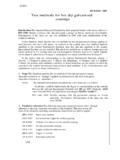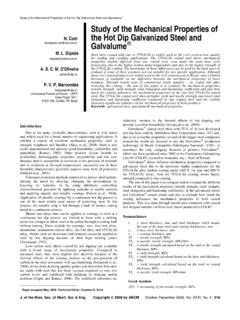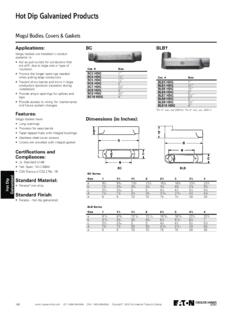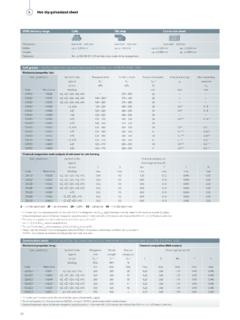Transcription of Corrosion Control by Hot Dip Galvanized Steel in …
1 Hot Dip Galvanized Information Sheet Corrosion Control by Hot Dip Galvanized Steel in water Hot Dip Galvanizing As the name implies, the application of the zinc coating is a hot dipping process whereby cleaned carbon Steel is immersed into molten zinc at a temperature of between 445 C and 450 C. When perfectly cleaned Steel is immersed into molten zinc, a chemical reaction, governed by metallurgical laws will result in the formation of tenacious zinc and / or zinc iron alloy coating. Figure One is a micrograph of such a coating applied to a sample of aluminium killed Steel . The adhesion of the coating to the carbon Steel is by means of a metallurgical bond, which is considered to be far superior to that of any mechanical bond.
2 Typically, the service life of a hot dip Galvanized coating is proportional to its thickness. The thicker the zinc coating, the longer the service life.. The characteristics of a hot dip Galvanized coating are summarized as follows. Relatively uniform and can range from a bright silvery to a dull gray surface finish, depending on the chemical analysis of the Steel being processed. Coating thickness usually between 55 to >100 micros ( m), depending on Steel thickness as well as the chemical composition of the Steel being processed. The coating consists of a series of zinc / iron layers, the formation of which are influenced by the chemical composition of the Steel being processed.
3 Zinc is electro-negative to carbon Steel and will therefore provide cathodic protection to the Steel should small uncoated surface imperfections arise. Eta - Layer Figure 1: Micrograph (x200) of a typical Hot Dip Galvanized coating 60 to 80 m Barrier Zeta - Layer on Aluminum Killed Steel . Protection Delta - Layer Gamma - Layer Steel Barrier Protection 1ST Line of Defence Protective Characteristics of Hot Dip Galvanized Coatings Immersed in water Natural ground water absorbs soluble salts as chlorides and sulphates. In addition, the use of modern chemicals in fertilisers, can add nitrates and phosphates to rivers. The level of acidity of water results from the amount of dissolved carbon dioxide absorbed from the atmosphere.
4 Similarly other soluble gases (such as oxygen, sulphur dioxide so called acid rain and hydrogen sulphide). can be absorbed by water . Therefore all ground waters encountered in nature are impure containing varying levels of chemicals and dissolved gases. Drinking water standards place tolerable limits on the level of these substances. All materials, employed for purposes of Corrosion Control , have distinctive characteristics in their reaction to the various ground waters encountered in nature. Hot dip Galvanized coated carbon Steel is no exception. Hot Dip Galvanized Information Sheet Corrosion Control by Hot Dip Galvanized Steel in water The following parameters are generally required to assess the corrosivity of water .
5 Table No. 1 Typical water Analysis Parameter Unit Typical Corrosive Mild Benign Values Temperature C 20. PH 7 to 7 <5 &>12 6 to 8 8 to 12. Chlorides (as Cl) mg/l <50. Sulphates (as SO3) mg/l <5. Alkalinity (as CaCO3) mg/l 15 to 30. Typical parameters required of a Calcium Hardness (as CaCO3) mg/l 30 to 100. water analysis in order to assess Total Hardness (as CaCO3) mg/l 50 to 150 its corrosivity and probability of Total Dissolved Solids mg/l 50 to 150 zinc corrosive properties. Conductivity Ms >200. Temperature and Pressure Chemical reactions are generally accelerated by a rise in temperature; roughly, the rate of a reaction is doubled by a temperature rise of 10 C.
6 This applies to Corrosion of zinc by water , but there may be other temperature dependent reactions which offset the rate of Corrosion , such as the precipitation of carbonates by displacement of the chalk-carbonic acid equilibrium, reduction in the dissolved oxygen content. Hot dip Galvanized piping is used for hot water supplies provided that the temperature does not exceed 65 C. At higher temperatures, the zinc will become electro-positive and hence cathodic to carbon Steel . It is recommended that caution be exercised where hot dip Galvanized systems are used above 65 C. Alternative or additional protective measures (Duplex) coatings need to be considered.
7 water pressure per s is not a major factor in Corrosion of zinc. However, it can have an indirect influence, such as increasing the oxygen retained in the water at low temperatures. Also note the effect of temperature, in combination with scale forming characteristics, discussed later in this paper. Influence of pH levels (Refer to figure 2). Zinc is an amphoteric metal, which means that it is soluble in acid (low pH) and also in high alkali (high pH) waters. The pH of water is of major importance as < the rate of Corrosion increases sharply unless inhibitors are present. Fundamentally however, the speed of Corrosion is dependent upon the type, quality and mode of precipitation of Corrosion products, with the most important zinc product of Corrosion being zinc carbonate (ZnCO 3).
8 The formation of a tightly adhering stable Barrier Protective zinc carbonate (ZnCO 3) film is required for the effective Corrosion protection of carbon Steel using any form of zinc coating. The zinc Corrosion products in acids (pH< ) are readily soluble in water . In strongly alkaline solutions (pH> ) water -soluble zincates are formed. The suitability of hot dip Galvanized coatings requires a pH range of > and < Time of wetness, agitation, suspended solids, hard or soft water and temperature all affect the formation of the ZnCO3 protective patina. page 2 of 7. Hot Dip Galvanized Information Sheet Corrosion Control by Hot Dip Galvanized Steel in water Zinc requires exposure to the environment for the formation of the ZnCO3 barrier protective film.
9 Stagnation can be unfavourable, while too much agitation may also erode the protective film. This action may be further assisted through erosion by Suitable for suspended solids. At low temperatures, compact, HDG. adherent protective deposits are formed, which at higher temperature may become porous and non- protective. ACI ALKA. D LINE. Scale Forming water Hard waters are scale forming, whereas the degree of softness of water reduces the scale- forming characteristics. Scale forming tendencies of water are governed by the relationship between the amounts of calcium (Ca), Magnesium (Mg), Sulphates (SO3), Carbonates (CO4--), Bi-Carbonates, Carbon Dioxide (CO2), temperatures, and total dissolved solids (TDS) in the water .
10 Figure 2: The reaction of pure zinc in a varying pH environment In general terms, Galvanized Steel is best suited to hard waters. Galvanized Steel is prone to attack in soft waters containing less than 50mg/litre calcium carbonate (CaCO 3). With scale-forming waters zinc has an extended life where the determining factor with pipes can often be the gradual reduction in the effective internal diameter due to the scaling phenomena resulting in excessive scale deposits. Hot dip Galvanized Steel with zinc coatings typically 60 -100. m thick, are widely used for pipes, water cylinders, tanks and handling domestic water systems with satisfactory results. A number of indices have been used to define the scale forming tendencies of water .








